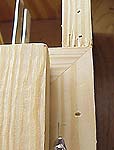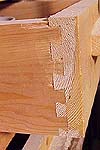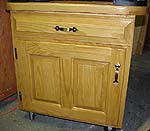This is a Veteran Owned site
| |
||||||
On-The-Job PracticeDeveloping skills in the shopText and photos by Tom Hintz A major part of the learning process faced by new woodworkers is developing the skill and confidence necessary to work with expensive wood, without wasting an excessive amount of it. The trick is understanding the techniques and getting comfortable with them before applying them to a "keeper" project. Marking and CuttingToo often, these basic procedures are considered "easy" and afforded little attention in the learning process. The truth is we all need to develop good marking and cutting habits, and then learn to use them consistently. If you can train yourself to use these procedures consistently during the learning process, they become habits that will save lots of wood and frustration in the future. For more on this subject see "Using Cut Lines" elsewhere on this site.
Using ScrapUsing scrap wood to learn the various jointery techniques is a common way to contain costs, something most of us must do. However, it is important to remember that not all woods are the same, especially in terms of hardness and compressibility. The close fit required by everything from mortise and tenon to dovetail joints means we have to cut mating pieces with proper clearances. If we practice in soft pine, there could be a surprise coming when that same joint is cut in harder wood. A joint that feels tap-together-snug in pine can be impossibly tight in hardwood. I had just such an experience recently when familiarizing myself with the Leigh dovetail jig. I was repeatedly cutting perfect-fitting half-blind dovetail joints in scrap pine. Making no setup changes, I cut the same dovetails in red oak and discovered I did not have a big enough hammer in the shop to drive the joint together. I made a slight adjustment in bit depth and the joints tapped together nicely when cut in oak or pine. Using cheap wood is fine for learning, but be sure to mix some hardwood into the latter stages of the process. I save hardwood scraps for just that reason. Setups, even ones I familiar with, have to be confirmed using wood similar in hardness to that being used for the project. Read, Watch, Get Hands-OnReading books, watching videos and cruising woodworking web sites can all benefit the process of learning woodworking techniques. It is important to remember that none of them represents a magic learning bullet. Hands-on practice is the only way to fully develop skills.
Recently, a new woodworker sent me an email asking how to gain the practice necessary to work with good wood and finished projects. He said that so far, all he had built was cabinets and a bench for his shop, none of which required the jointery he would use in the in-the-house projects he wanted to build. This is an opportunity many woodworkers miss. Building the cabinets, doors, drawers, carts and benches most shops need represents a great way to gain real-world experience with many woodworking techniques. Too often, we place little value on shop-only projects and use fast, overly simple techniques. One my first shop projects was a workbench with 14 drawers. While pondering how to approach this project, I had a fortunate, well-timed, and rare brainstorm. I had planned to build the drawers using rabbet joints bolstered by glue and nails. About that time, I bought my first dovetail jig and realized all those drawers afforded the opportunity to gain experience with dovetailing. I only scrapped out one drawer, found out why dovetails are seldom used with plywood, and made a few that looked a little scary but were strong. The rest of the drawers came out pretty good and all remain in use four years later with no signs of failure. To increase the amount of training this group of drawers provided I dovetailed all four corners of each one. This is a practice I continue to use today on many of my projects. Whenever I build doors for shop cabinets I use flat panels to conserve the amount of wood needed. To gain all the experience I can all are made with either mortise and tenon or stub tenon and groove joints. I could simply biscuit them together, and they would work. However, using biscuits does nothing for improving my other jointing skills. My shop cabinets have face frames, all of which feature either mortise and tenon or mitered corners. The shelves are all set into dados, the backs all recessed in rabbets.
When I built my router table base, I had recently purchased my Jesada raised panel door router bit set. To help get familiar with using it, I made a raised panel door and drawer front for my router table base. Yes, the drawer box is dovetailed on all four corners! Though some have called my router base excessive for a piece of shop equipment, I learned to use the new bit set and wound up with a very attractive and stout router base to boot. The point is that while it would have been faster, easier and in some cases a little cheaper to simply whack my shop projects together, I would have missed out on a lot of practical experience. Since I was going to build them anyway, why not use them for on-the-job training? The additional time, and perhaps a little extra money, invested in these projects have saved many times that in the projects I applied these skills to later. Practice on scrap wood will always be necessary. However, if we learn to make use of the opportunities our shop projects afford us, we can be more prepared for working with more complex and costly projects in the future. Do you have a comment about this page? - Email Me! |
All written, photographic and drawn materials are property of and copyright by NewWoodworker.com LLC 2000-2019. Materials may not be used in any way without the written permission of the owner.



